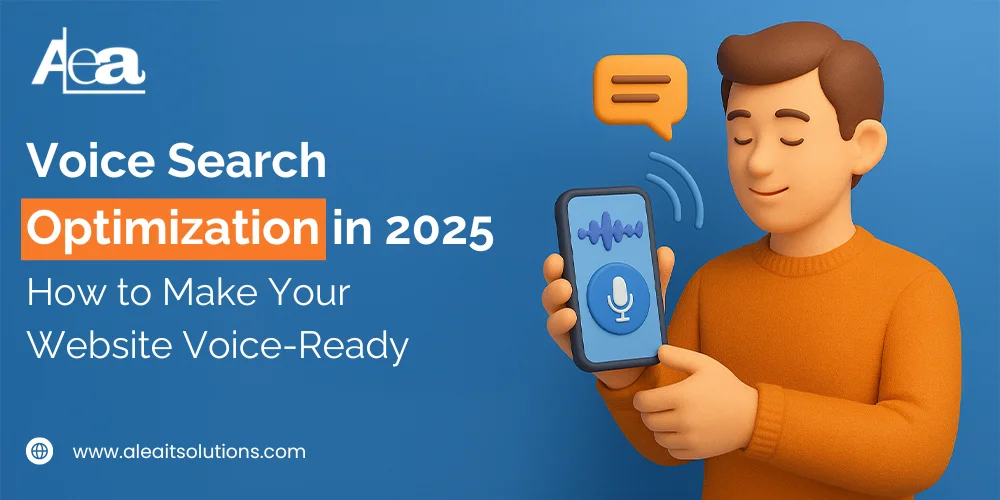It’s 2025, and if your website still isn’t optimized for voice search, you’re already falling behind.
Smart speakers, mobile phones, in-car systems, and even wearable devices have made voice interaction second nature for millions. People no longer just type into search bars they speak naturally to their devices and expect fast, clear answers. For growing businesses and modern development teams, adapting to this shift isn’t optional anymore. It’s a key part of staying relevant and competitive.
In this guide, we’ll explore what voice search optimization really means today, why it’s a critical part of your web strategy, and how dev and SEO teams can work together to create websites that are fast, intelligent, and ready to meet users where they are talking.
Why Voice Search Has Become a Big Deal
Voice search isn’t some futuristic trend, it’s how people are already searching, choosing, and buying.
Let’s look at a few numbers that tell the story:
- By the end of 2025, more than 8.4 billion voice assistants will be active worldwide. That’s more devices than people.
- Over 76% of smart speaker owners run local searches every week.
- 62% of drivers use in-car voice assistants to find nearby services while on the road.
- One in four mobile users turns to voice search every single day.
With smart devices becoming more conversational, users now expect the same kind of interaction from the websites they visit. If your content isn’t easy to find or easy to hear it’s already being skipped.
What Voice Search Optimization Really Means
Voice search optimization goes far beyond just tweaking a few keywords. It’s about adjusting your entire digital presence, so it fits how people naturally speak and ask questions out loud.
In plain terms, it means creating content, structuring pages, and setting up backend systems in a way that helps voice assistants clearly understand what your site is about and how it can help the user.
Why it matters:
- Search engines now Favor content that answers spoken queries clearly and directly.
- Users are often in motion when using voice, so they expect fast and simple answers.
- Optimized sites are more likely to appear in top placements like featured snippets, map results, and those valuable “near me” spots.
What Powers Voice Search: The Tech Behind It
To build websites that work well with voice, it helps to understand what’s happening under the hood.
1. Natural Language Processing (NLP)
When someone says, “Where can I get vegan chocolate near me?” they’re not thinking in keywords. NLP allows search engines to interpret that conversational tone and figure out what the user actually wants. Your content should be written in that same natural, question-based style.
2. Conversational UX
It’s not just about words, it’s about flow. A voice-friendly website should feel like a conversation. That means helpful FAQ sections, smart navigation, and microcopy that anticipates the next step, rather than dumping data on the user.
3. Structured Data
Want your content to show up in voice search results? Make it easy for search engines to understand what your pages are about. Schema markup (especially for things like locations, events, products, and FAQs) gives your site the context it needs to stand out.
4. Clean HTML and Featured Snippets
Voice assistants often pull answers from featured snippets. Using proper HTML tags like <article>, <section>, and <header> helps search engines understand which parts of your content matter most.
How to Make Your Website Voice-Ready: Practical Steps
Let’s turn that theory into action. Here’s what your team should actually be doing.
Write the Way People Talk
If your website still sounds like a keyword-stuffed brochure, it’s time for a change. Voice-friendly content is built around questions like:
- “How do I fix this issue?”
- “What’s the best way to do X?”
- “Why is Y happening to my app?”
Use tools like Google Search Console or review your chatbot logs to find the actual questions your users are asking. Then answer those questions clearly and conversationally.
Prioritize Mobile and Speed
Voice searches often happen when people are on the move. That makes performance a deal-breaker. Your site needs to load fast, feel responsive, and follow Core Web Vitals guidelines. If it doesn’t, you’re not just hurting your search rankings you’re disappointing users in real time.
Use a Logical Structure
Clean content layout helps both voice bots and real people find answers quickly. Follow a structure that’s easy to scan:
- Use proper heading levels (h1, h2, h3) in a clear hierarchy
- Stick to one topic per section
- Keep paragraphs short and focused
Technical Challenges (and How to Tackle Them)
Voice optimization isn’t just a content writer’s job. There are real engineering hurdles, especially if your product is scaling fast.
Dealing With Long and Vague Queries
Voice queries aren’t short they’re often detailed or ambiguous. To make sure your site handles them well:
- Use internal search tools with NLP or semantic capabilities
- Build systems that understand intent, not just keywords
- Create fallback responses for queries you can’t answer perfectly
Making Your Content Work on Voice Platforms
Want your content to show up when someone talks to Alexa or Google Assistant? You may need to follow specific formatting guidelines and sometimes even register your content with those ecosystems as voice “skills” or “actions.”
Accessibility Still Matters
Just because someone’s using voice doesn’t mean they’re hands-free or screen-free. Follow accessibility standards (like WCAG), support screen readers, and think about how assistive tech users experience your site.
Developers and SEO Need to Collaborate
Getting this right takes teamwork. Developers and SEO specialists have to stay in sync.
- Dev teams should lead performance, APIs, semantic HTML, and accessibility.
- SEO teams should shape tone, help identify target queries, and plan out structured data.
Treat voice search like a cross-functional initiative, not a side project. Schedule regular check-ins between content and engineering to keep things aligned.
Why Jamstack and Headless CMS Make a Big Difference
If your company is growing, and you care about speed and flexibility, consider Jamstack and headless CMS. These tools are not just trendy they’re incredibly effective for voice-optimized sites.
A headless CMS lets you write content once and push it out to multiple channels: web, mobile, smart speakers, wearables, and more. Jamstack delivers content via pre-rendered pages on a CDN, which means lightning-fast load times and seamless integrations with third-party APIs including voice.
Voice assistants work best with content that’s structured and served fast. That’s exactly what Jamstack was built for.
The Real Question: Is Your Website Speaking Back?
People are already using their voices to search. If your website isn’t built to respond clearly and quickly, you’re missing out on real opportunities to connect.
At ALEAIT Solutions, we help businesses design and build websites that aren’t just voice-friendly they’re voice-smart. From backend decisions to content design to integrating with voice platforms, we work as a true technology partner, not just another service provider.
If you’re a startup or growing business looking to scale with confidence in 2025, voice search optimization needs to be part of your strategy.
Let’s build it right from the start.




